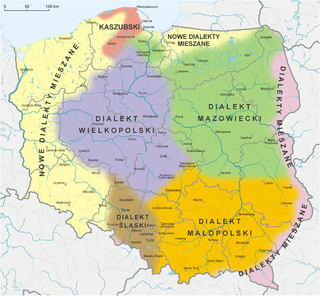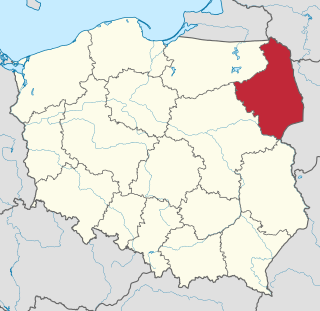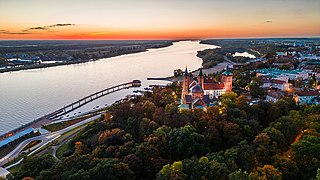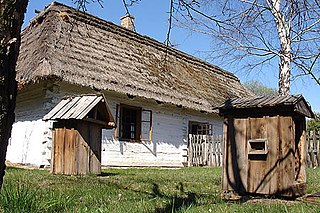
Masovian Voivodeship or Mazowieckie Province or Mazowieckie Voivodeship or Mazovian Voivodeship or Mazovian Province, etc. is a voivodeship (province) in east-central Poland, containing Poland's capital Warsaw.

The Masurian ethnolect, according to some linguists, is a dialect group of the Polish language; others consider Masurian to be a separate language, spoken by the Masurian people in northeastern Poland.

A digraph or digram is a pair of characters used in the orthography of a language to write either a single phoneme, or a sequence of phonemes that does not correspond to the normal values of the two characters combined.

Masovians, also spelled as Mazovians, and historically known as Masurians, is an ethnographic group of Polish people that originates from the region of Masovia, located mostly within borders of the Masovian Voivodeship, Poland. They speak the Masovian dialect of Polish.

The Warsaw subdialect, or Warsaw dialect, is a regional subdialect of the Masovian dialect of the Polish language, centered on the city of Warsaw. It evolved as late as the 18th century, under notable influence of several languages spoken in the city. After the destruction of Warsaw in the aftermath of the Warsaw Uprising of 1944 the subdialect has been in decline. It is estimated that in modern times it is almost extinct as the native language and is preserved mostly in literary works.
The phonological system of the Polish language is similar in many ways to those of other Slavic languages, although there are some characteristic features found in only a few other languages of the family, such as contrasting postalveolar and alveolo-palatal fricatives and affricates. The vowel system is relatively simple, with just six oral monophthongs and arguably two nasals in traditional speech, while the consonant system is much more complex.
The Lwów dialect is a subdialect (gwara) of the Polish language characteristic of the inhabitants of the then Polish city of Lviv, now in Ukraine. Based on the substratum of the Lesser Polish dialect, it was heavily influenced by borrowings from other languages spoken in Galicia, notably Ukrainian (Ruthenian), German and Yiddish,

Polish dialects are regional vernacular varieties of the Polish language.

The Niemodlin dialect is a Silesian dialect, used in the parts of the city of Niemodlin, Poland. It slightly differs from standard Silesian by having a characteristic pronunciation called mazuration (mazurzenie), which means that the consonants cz sz ż dż are pronounced as the alveolars c s z dz. In Niemodlin Silesian phonology a nasalized vowel y may also occur.

Podlaskie Voivodeship is a voivodeship (province) in northeastern Poland. The name of the province refers to the historical region of Podlachia, and part of its territory corresponds to this region. The capital and largest city is Białystok.
Mazurzenie or mazuration is the replacement or merger of Polish's series of postalveolar fricatives and affricates into the dentialveolar series. This merger is present in many dialects, but is named for the Masovian dialect.

Legia Warsaw II, in Poland known as Legia II Warszawa, is a Polish football team, which serves as the reserve side of Legia Warsaw. They compete in the III liga, the fourth division of Polish football, and play their home matches at the Legia Training Center in Książenice.

Mazovia or Masovia is a historical region in mid-north-eastern Poland. It spans the North European Plain, roughly between Łódź and Białystok, with Warsaw being the unofficial capital and largest city. Throughout the centuries, Mazovia developed a separate sub-culture featuring diverse folk songs, architecture, dress and traditions different from those of other Poles.

Lasovians are a subethnic group of the Polish nation, who reside in Lesser Poland, at the confluence of the Vistula and the San rivers, Subcarpathian Voivodeship, southeastern Poland. They are descended from various ethnic groups, which settled in the dense Sandomierz Forest across centuries, with a dominant Polish element. The Lasowiacy were formed as a separate subethnic group in the late 19th and early 20th century. They use their own dialect, which belongs to Lesser Polish dialect cluster of the Polish language. Like most Poles, the Lasowiacy are Roman Catholics.
PalatalizationPA-lə-tə-leye-ZAY-shən is a historical-linguistic sound change that results in a palatalized articulation of a consonant or, in certain cases, a front vowel. Palatalization involves change in the place or manner of articulation of consonants, or the fronting or raising of vowels. In some cases, palatalization involves assimilation or lenition.

Podlachian language is an East Slavic literary microlanguage based on the East Slavic dialects spoken by inhabitants of the southern part of Podlachian Province in Poland between the Narew (north) and Bug (south) rivers. The native speakers of these dialects usually refer to them by the adverbial term po-svojomu. The unequivocal academic classification of the po-svojomu dialects has been disputed for many years among linguists as well as activists of ethnic minorities in Podlachia, who classify them as either Belarusian dialects with Ukrainian traits or Ukrainian dialects.

Jabłonkowanie or siakanie is a regional phonological feature of the Polish language. It consists of the merger of the series of retroflex sibilants ⟨sz, cz, ż, dż⟩ and palatal sibilants ⟨ś, ć, ź, dź⟩ into a phonetically-intermediate series.

Northern Borderlands dialect is a dialect of the Polish language, spoken by the Polish minorities in Lithuania and in northwestern Belarus.

Southern Borderlands dialect is a dialect of the Polish language, spoken by the Polish minority in Ukraine. It is considered a branch of the Lesser Poland dialect by Zofia Kurzowa.














